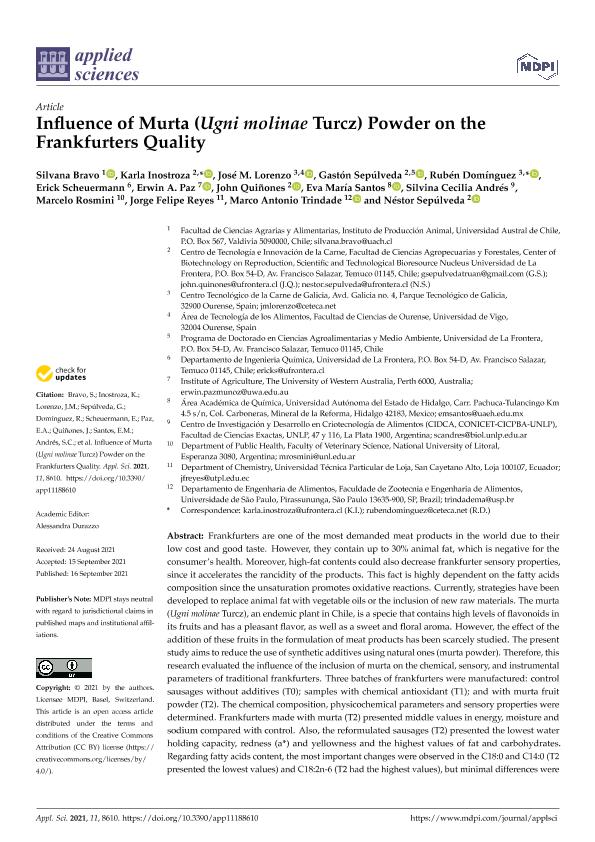Artículo
Influence of Murta (Ugni molinae Turcz) Powder on the Frankfurters Quality
Bravo, Silvana; Inostroza, Karla; Lorenzo, José M.; Sepúlveda, Gastón; Domínguez, Rubén; Scheuermann, Erick; Paz, Erwin A.; Quiñones, John; Santos, Eva María; Andres, Silvina Cecilia ; Rosmini, Marcelo Raul; Reyes, Jorge Felipe; Trindade, Marco Antonio; Sepúlveda, Néstor
; Rosmini, Marcelo Raul; Reyes, Jorge Felipe; Trindade, Marco Antonio; Sepúlveda, Néstor
 ; Rosmini, Marcelo Raul; Reyes, Jorge Felipe; Trindade, Marco Antonio; Sepúlveda, Néstor
; Rosmini, Marcelo Raul; Reyes, Jorge Felipe; Trindade, Marco Antonio; Sepúlveda, Néstor
Fecha de publicación:
09/2021
Editorial:
Multidisciplinary Digital Publishing Institute
Revista:
Applied Sciences
e-ISSN:
2076-3417
Idioma:
Inglés
Tipo de recurso:
Artículo publicado
Clasificación temática:
Resumen
Frankfurters are one of the most demanded meat products in the world due to their low cost and good taste. However, they contain up to 30% animal fat, which is negative for the consumer’s health. Moreover, high-fat contents could also decrease frankfurter sensory properties, since it accelerates the rancidity of the products. This fact is highly dependent on the fatty acids composition since the unsaturation promotes oxidative reactions. Currently, strategies have been developed to replace animal fat with vegetable oils or the inclusion of new raw materials. The murta (Ugni molinae Turcz), an endemic plant in Chile, is a specie that contains high levels of flavonoids in its fruits and has a pleasant flavor, as well as a sweet and floral aroma. However, the effect of the addition of these fruits in the formulation of meat products has been scarcely studied. The present study aims to reduce the use of synthetic additives using natural ones (murta powder). Therefore, this research evaluated the influence of the inclusion of murta on the chemical, sensory, and instrumental parameters of traditional frankfurters. Three batches of frankfurters were manufactured: control sausages without additives (T0); samples with chemical antioxidant (T1); and with murta fruit powder (T2). The chemical composition, physicochemical parameters and sensory properties were determined. Frankfurters made with murta (T2) presented middle values in energy, moisture and sodium compared with control. Also, the reformulated sausages (T2) presented the lowest water holding capacity, redness (a*) and yellowness and the highest values of fat and carbohydrates. Regarding fatty acids content, the most important changes were observed in the C18:0 and C14:0 (T2 presented the lowest values) and C18:2n-6 (T2 had the highest values), but minimal differences were observed in the total SFA, MUFA and PUFA content. Cholesterol content from T2 were similar to the control samples, and T1 presented the highest values. Although these differences, both chemical and nutritional quality of all frankfurters manufactured in the present study were very similar among treatments. Finally, according to the sensory analysis, T2 presented better acceptability and sensory characteristics compared with the other treatments (p ≤ 0.05). Therefore, the inclusion of murta in the production of frankfurters could be a strategy to improve the sensory characteristics of this product with minimal changes in chemical and nutritional properties. However, the effect of murta on oxidative stability and frankfurter shelf-life should be studied in depth in future research.
Palabras clave:
NATIVE BERRIES
,
NATURAL ADDITIVES
,
MEAT PRODUCTS
,
SENSORY ATTRIBUTES
Archivos asociados
Licencia
Identificadores
Colecciones
Articulos(CIDCA)
Articulos de CENTRO DE INV EN CRIOTECNOLOGIA DE ALIMENTOS (I)
Articulos de CENTRO DE INV EN CRIOTECNOLOGIA DE ALIMENTOS (I)
Citación
Bravo, Silvana; Inostroza, Karla; Lorenzo, José M.; Sepúlveda, Gastón; Domínguez, Rubén; et al.; Influence of Murta (Ugni molinae Turcz) Powder on the Frankfurters Quality; Multidisciplinary Digital Publishing Institute; Applied Sciences; 11; 18; 9-2021; 1-18
Compartir
Altmétricas



